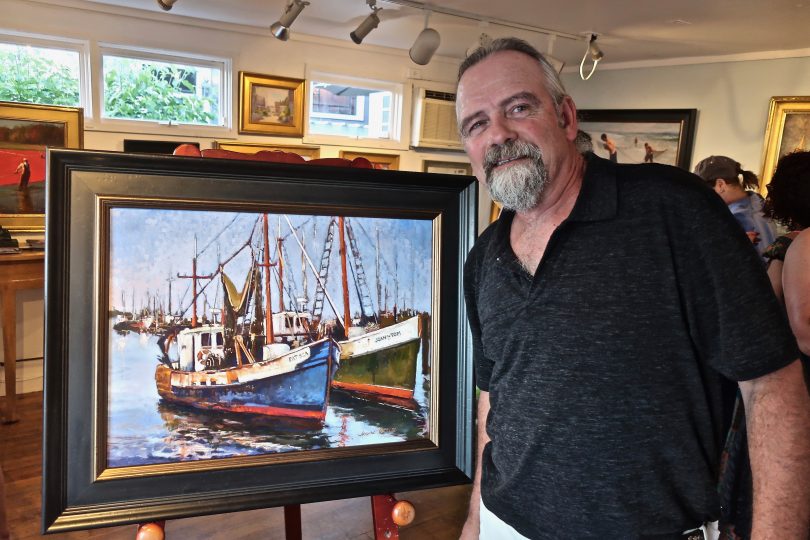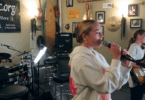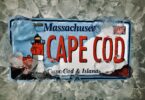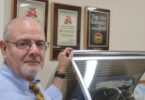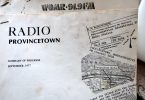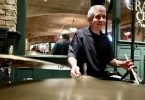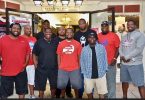PROVINCETOWN – This past weekend, 1,000 people were walking around Provincetown wearing Jerome Greene’s artwork. In his own way, he painted the town. It’s what he’s done since he arrived 12 years ago. From the East End, where 18 pieces of his artwork had an opening at the Arthur Egeli Gallery to the West End…
You may also like
“Making dreams come true at Mark’s Music”: Mark Filteau, A Profile
Frozen Out: As ICE Acts on Cape Cod, Locals React
Harvest Days: Remembering Michael Pearson’s Harvest Gallery Wine Bar
The Grab Brothers Make Hippie Happy Music – A Profile
The “Functional Art” of Walter Baron, Boatbuilder – A Profile
Follow The Money, and The Good Vibe; Why Shop Local – An Essay
Making Things Happen; Attorney Bruce Bierhans – A Profile
Are We Winning? In Our Summer Paradise, Summer Is Warmer & Longer
Dream Job: Rich Rogers’ Blue Collar Path to WMVY – A Profile
Dan McKeon: Ptown’s Available Housing Matchmaker – A Profile
Mwalim: Da Phunkee Professor, Artist, Writer & Groovalotto – A Profile
Zoe Lewis: Provincetown’s Jazzy Zen Vaudeville Vagabond – A Profile
ArtsCape: The Quirky Creations of Sue Beardsley
Andy Dufresne: 91 Candles For Falmouth’s Civic-Minded Barber – A Profile
WOMR At 40; An Outermost Radio Tale of Audacity & Tenacity
Saving East End Books; A Community’s Love & Jeff Peters’ “nerves of steel”
Jill Erickson: A Town Librarian Retires – A Profile
Mike Houghton, Once Upon A Time At Jasper’s Surf Shop – A Profile In Memoriam
Bart Weisman “the Jazz Mayor Of Cape Cod” – A Profile
Ripple Effect — Rising House Prices, Summer & Cape Cod’s Future
Christin Marshall of EforAll; Evangelist For Entrepreneurs – A Profile
Meet The Jitters – The Cape Cod Band Formed By The Pandemic & Technology
2020 in 5 Minutes, A VIDEO – Music By Chandler Travis
In A Close Election, Would The Losing Side Accept The Result? Cape Politicians & Activists Weigh In
EXCLUSIVE: Details of Ron Beaty’s “Baggage” In An Election Like No Other
Breaking The News – An Essay About Local Journalism On Cape Cod
Twist & Maybe Don’t Shout – Talking To Cape Musicians About Summer Music During A Pandemic
People Of Action, And The Work To Keep Peace On The Cape
“Who’s going to cut your filet mignon?” – Realtors On The Cape Housing Crisis
Mr. Positivity; Jonathan Thompson Chronicles Happiness – A Profile
About the author
Brian Tarcy
Brian Tarcy is co-founder of Cape Cod Wave. He is a longtime journalist who has written for the Boston Globe, Boston magazine, the Cape Cod Times and several other publications. He is the author of "YOU CAN'T SELL RIGHT FIELD; A Cape Cod Novel." He is also the author or co-author of more than a dozen mostly non-fiction books, including books with celebrity athletes Cam Neely, Tom Glavine and Joe Theisman. His previous book was, "ALMOST: 12 Electric Months Chasing A Silicon Valley Dream" with Hap Klopp,who created the iconic brand, The North Face.
For more information, see Briantarcy.com
Brian is a long-suffering Cleveland Browns fan with a long-running NFL predictions/political satire column connecting weekly world events to the fate of his favorite team, now at Whatsgonnahappen.com.

